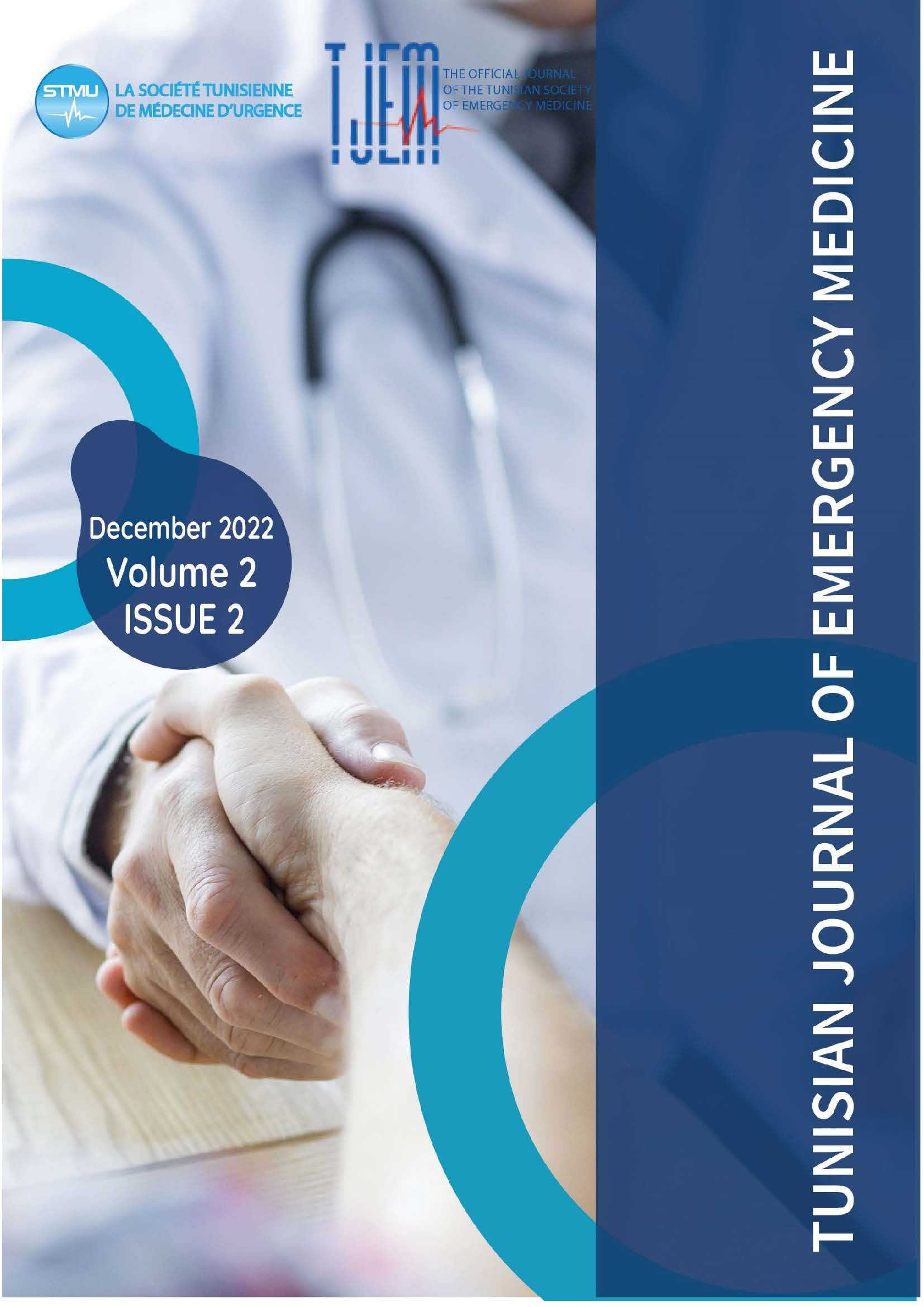Evaluation of the prescription of additional examinations in emergency departments
DOI:
https://doi.org/10.0000/270fs198Keywords:
Complimentary tests, Blood tests, Imaging, Evaluation, Emergency department, ManagementAbstract
Objectives: This study aimed to describe the state of play of the prescription of additional examinations in the emergency department and to analyze the contribution of additional examinations in the treatment of acute pathologies, as well as the benefit of their prescription.
Methods: Prospective study including patients in the emergency department. A standardized questionnaire was completed by the clinician (resident, resident, or senior doctor) responsible for the initial management of the patient.
Results: 179 patients including 42.4% men and 57.6% women were included in our study, additional examinations were carried out on 144 patients; 80.4% of the population; 728 examinations. 494 examinations were biological (67.85%), 105 radiological examinations (14.42%) and 129 other types (17.73%). 68.7% of these exams were prescribed by interns, 29.6% by residents, and only 1.7% by seniors who were only notified in 48% of cases.
Among the additional examinations requested, 61.03% of the biological examinations were of little or no contribution to the diagnosis and therefore inappropriate.
We found that 30.8% of the radiological examinations requested were of little or no contribution to the diagnosis and therefore inappropriate, among the most incriminated are Abdominal X-rays in 100% of cases and X-rays of the urinary tract. 78.8% of the diagnoses made after the complementary examinations agree with the initial hypothesis
diagnosis at the end of the clinical examination. To improve the behavior of the doctors prescribing these additional examinations and to reduce abuse, it is necessary to have good training of the doctors on the recommendations and the diagnostic value added by the additional examinations as well as the establishment of the protocol of prescriptions.
Overall residence time is also considered to be the key parameter for clinical progress and operational efficiency and explains the congestion in the emergency department. During our study, the ORT was 10 min to 1540 min with an average length of stay (ALS) estimated at 61 min without additional examinations and 3 h 33 min with a request for additional examinations.
One of the main causes of the delay in recovering additional examinations is the lack of coordination and management of the various health personnel, doctors, nurses, and stretcher-bearers.
Conclusion: Despite the existence of recommendations, a large number of additional examinations are unnecessarily prescribed to emergency departments. These prescriptions are responsible for an increase in the time and cost of treatment.
Downloads
Published
Issue
Section
License
Copyright (c) 2022 Tunisian Journal of Emergency Medicine

This work is licensed under a Creative Commons Attribution-NonCommercial-ShareAlike 4.0 International License.
How to Cite
Similar Articles
- Sondes laajimi, haifa bradai, Nabil Chebbi, Dorra Loghmari , imen EL KISSI, Naoufel Chebili , rabeb Mbarek, Specific Features of Chest Pain in Young People treated in Prehospital Care , Tunisian Journal of Emergency Medicine: Vol. 3 No. 1 (2025): TJEM 2025: Vol.3 Issue 1
- Sarra Akkari , Emna Rachdi , Jalila Ben Khlil , Prognosis in COVID-19: Impact of Pre-hospital Emergency Care , Tunisian Journal of Emergency Medicine: Vol. 2 No. 4 (2024): TJEM Vol2 Issue4
- Faiza Safi, Traditional Medicine with Cade Oil in Pediatric Emergency Care , Tunisian Journal of Emergency Medicine: Vol. 2 No. 4 (2024): TJEM Vol2 Issue4
- Fatma MHIRI, Aimen Dammak, Faiza Safi, Oumaima KHARDENI , Faten DHOUIB, Olfa chakroun-walha, Diagnostic Challenges and Treatment Strategies in Axillary Trauma: A Case Report , Tunisian Journal of Emergency Medicine: Vol. 2 No. 4 (2024): TJEM Vol2 Issue4
- olfa djebbi, A dramatic course of COVID-19-associatedmeningoencephalitis without respiratoryinvolvement: a case report , Tunisian Journal of Emergency Medicine: Vol. 2 No. 4 (2024): TJEM Vol2 Issue4
- Rania Hammami, Syrine Triki, Aimen Dammak, Faiza Safi, Olfa Chakroun , An abrupt cardiogenic shock in a female at the era of COVID 19 pandemic lockdown , Tunisian Journal of Emergency Medicine: Vol. 3 No. 1 (2025): TJEM 2025: Vol.3 Issue 1
- Rabeb Mbarek, Khouloud Hamdi, Sarra Soua, Hela Abroug, Sondes laajimi, haifa Bradai, Dorra Loghmari , Asma SRIHA, Semir Nouira, Prehospital Particularities of Covid-19 infection and factors associated with its severity during the omicron variant wave (East-center of Tunisia) , Tunisian Journal of Emergency Medicine: Vol. 2 No. 4 (2024): TJEM Vol2 Issue4
- Asma ZORGATI, Short and long-term outcomes of patients presenting with Acute Coronary Syndrome without ST-segment elevation (NSTE -ACS): findings from a Tunisian Register: the ReSCUS Register , Tunisian Journal of Emergency Medicine: Vol. 2 No. 2 (2022): TJEM Vol2 Issue2
- Haifa BRADAÏ, Rabeb Mbarek, Sondes Laajimi, Dorra Loghmari, Mounir NAIJA, Atrial flutter mimicking ST-elevation myocardial infarction: A case report , Tunisian Journal of Emergency Medicine: Vol. 3 No. 1 (2025): TJEM 2025: Vol.3 Issue 1
- Rahma JABALLAH, A new practical score for early diagnosis of appendicitis in the emergency department , Tunisian Journal of Emergency Medicine: Vol. 2 No. 2 (2022): TJEM Vol2 Issue2
You may also start an advanced similarity search for this article.
Most read articles by the same author(s)
- Houda BEN SOLTANE, Predicting diabetic ketoacidosis severity score: proposal of a therapeutic strategy adapted to emergency department , Tunisian Journal of Emergency Medicine: Vol. 2 No. 3 (2023): TJEM Vol2 Issue3
- Houda BEN SOLTANE, A total volvulus of the small intestine on malrotation A total volvulus of the small intestine on malrotation A total volvulus of the small intestine on malrotation A total volvulus of the small intestine on malrotation A total volvulus of the small intes , Tunisian Journal of Emergency Medicine: Vol. 2 No. 3 (2023): TJEM Vol2 Issue3
- Houda BEN SOLTANE, Neurologic manifestations of infective endocarditis , Tunisian Journal of Emergency Medicine: Vol. 2 No. 3 (2023): TJEM Vol2 Issue3
- Houda BEN SOLTANE, Predicting diabetic ketoacidosis severity score: proposal of a therapeutic strategy adapted to the emergency department , Tunisian Journal of Emergency Medicine: Vol. 2 No. 2 (2022): TJEM Vol2 Issue2

